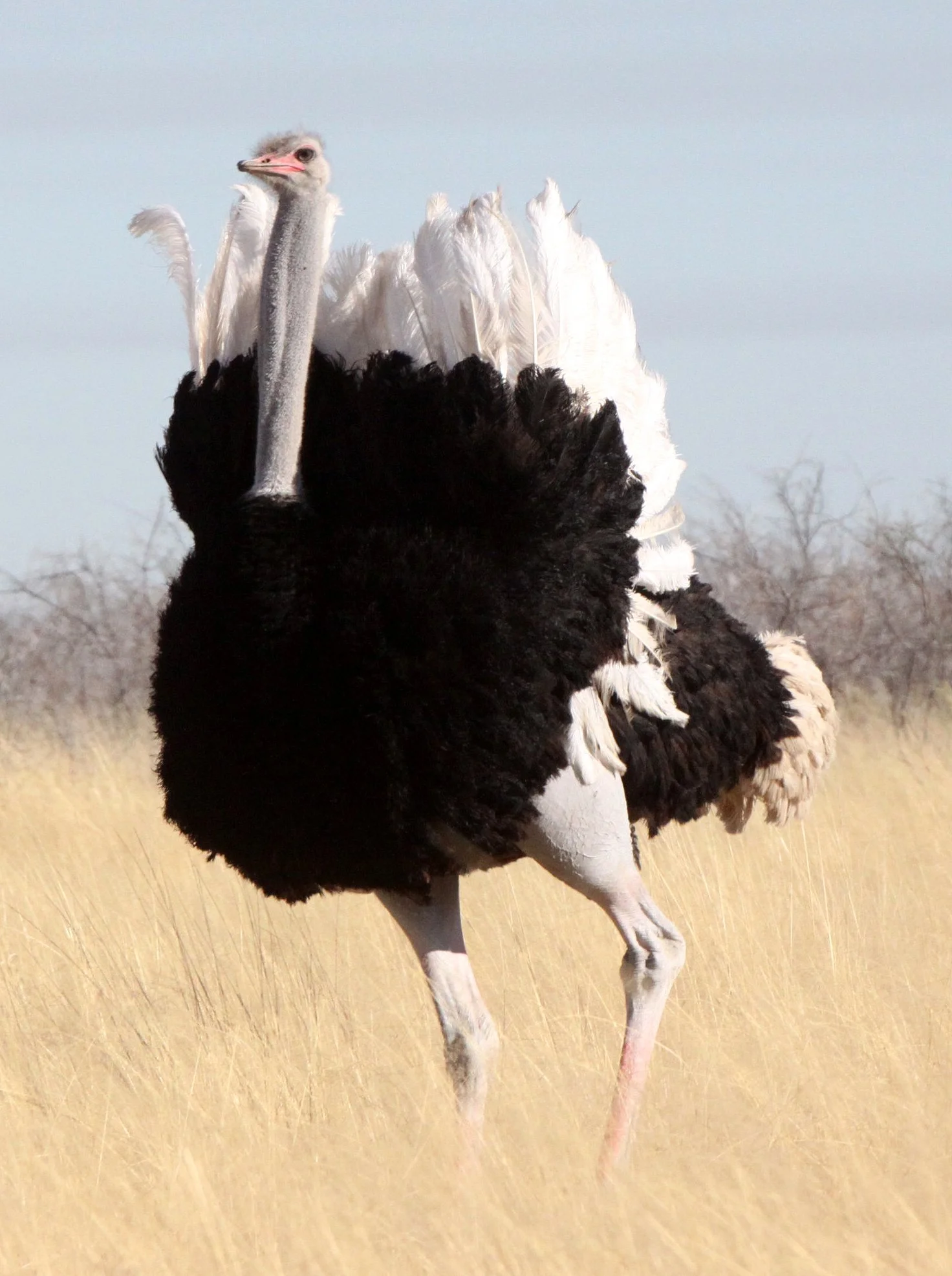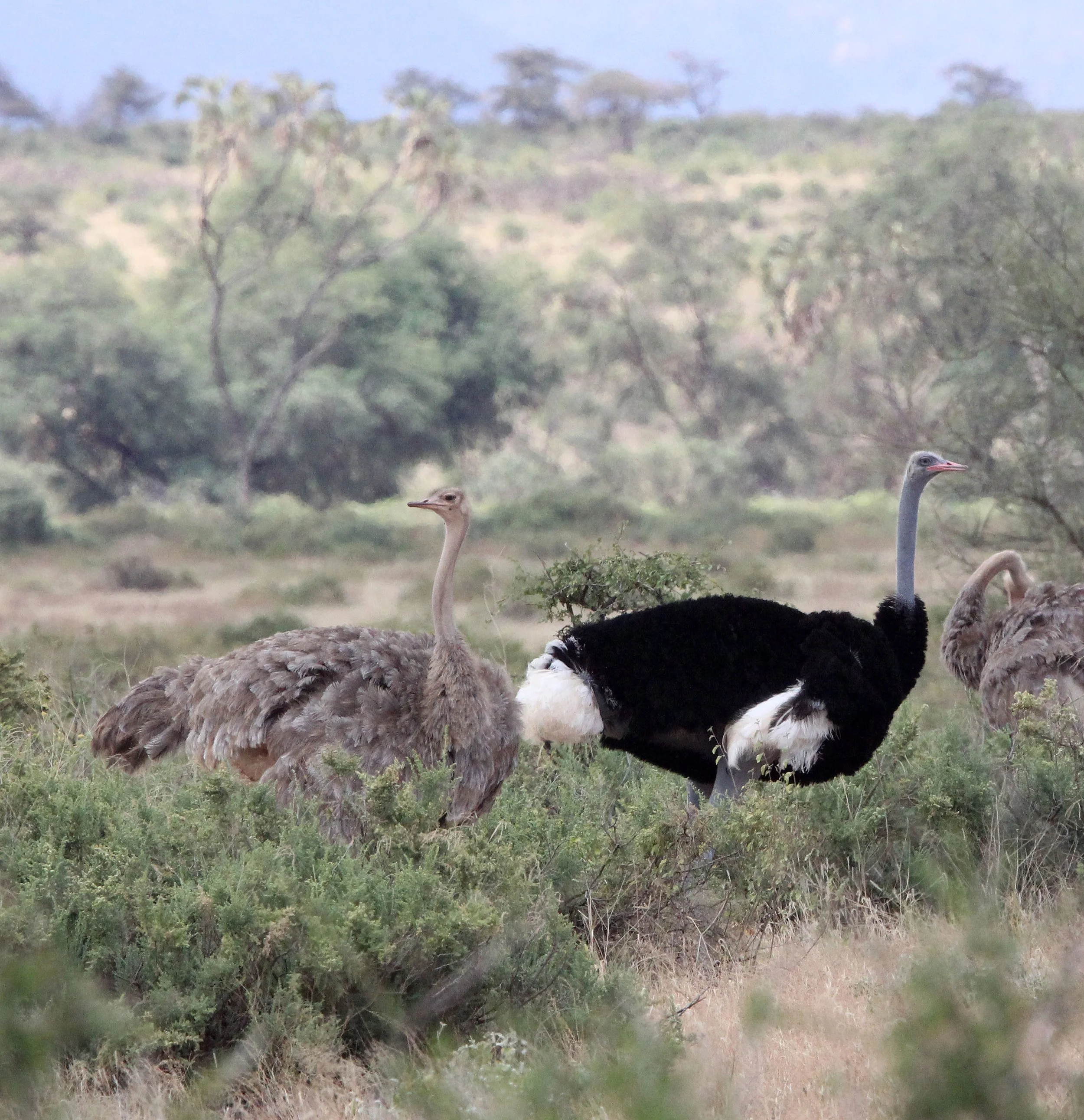
Ratites

A ratite is any of a diverse group of flightless, large, long-necked, and long-legged birds of the infraclass Palaeognathae. Kiwi, the exception, are much smaller and shorter-legged and are the only nocturnal extant ratites.
South African Ostrich male displaying to a receptive female in Namibia
The systematics of and relationships within the paleognath clade have been in flux. Previously, all the flightless members had been assigned to the order Struthioniformes, which is more recently regarded as containing only the ostrich. The modern bird superorder Palaeognathae consists of ratites and the flighted Neotropic tinamous (compare to Neognathae). Unlike other flightless birds, the ratites have no keel on their sternum — hence the name, from the Latin ratis (raft, a vessel which has no keel - in contradistinction to extant flighted birds with a keel). Without this to anchor their wing muscles, they could not have flown even if they developed suitable wings. Ratites are a paraphyletic group; tinamous fall within them, and are the sister group of the extinct moa. This implies that flightlessness is a trait that evolved independently multiple times in different ratite lineages.
Most parts of the former supercontinent Gondwana have ratites, or did have until the fairly recent past. So did Europe in the Paleocene and Eocene, from where the first flightless paleognaths are known. Ostriches were present in Asia as recently as the Holocene, although the genus is thought to have originated in Africa. However, the ostrich order may have evolved in Eurasia. A recent study posits a Laurasian origin for the clade. Geranoidids, which may have been ratites, existed in North America.
The African ostrich is the largest living ratite. A large member of this species can be nearly 2.8 metres (9.2 ft) tall, weigh as much as 156 kilograms (344 lb), and can outrun a horse.
Of the living species, the Australian emu is next in height, reaching up to 1.9 metres (6.2 ft) tall and about 50 kilograms (110 lb). Like the ostrich, it is a fast-running, powerful bird of the open plains and woodlands.
Also native to Australia and the islands to the north are the three species of cassowary. Shorter than an emu, but heavier and solidly built, cassowaries prefer thickly vegetated tropical forest. They can be dangerous when surprised or cornered because of their razor-sharp talons. In New Guinea, cassowary eggs are brought back to villages and the chicks raised for eating as a much-prized delicacy, despite (or perhaps because of) the risk they pose to life and limb. They reach up to 1.7 metres (5.6 ft) tall and weigh as much as 59 kilograms (130 lb)
American Rhea in the Northern Pantanal, Brazil
South America has two species of rhea, large fast-running birds of the Pampas. The larger American rhea grows to about 1.4 metres (4.6 ft) tall and usually weighs 15 to 40 kilograms (33–88 lb).
The smallest ratites are the five species of kiwi from New Zealand. Kiwi are chicken-sized, shy, and nocturnal. They nest in deep burrows and use a highly developed sense of smell to find small insects and grubs in the soil. Kiwi are notable for laying eggs that are very large in relation to their body size. A kiwi egg may equal 15 to 20 percent of the body mass of a female kiwi. The smallest species of kiwi is the little spotted kiwi, at 0.9 to 1.9 kilograms (2.0–4.2 lb) and 35 to 45 centimetres (14–18 in).
Loss of flight allows birds to eliminate the costs of maintaining various flight-enabling adaptations like high pectoral muscle mass, hollow bones and a light build, et cetera. The basal metabolic rate of flighted species is much higher than that of flightless terrestrial birds. But energetic efficiency can only help explain the loss of flight when the benefits of flying are not critical to survival.
Seeing the massive claws of the Southern Cassowary encountered in the Daintree Rainforest was intimidating.
Research on flightless rails indicates the flightless condition evolved in the absence of predators. This shows flight to be generally necessary for survival and dispersal in birds. In apparent contradiction to this, many landmasses occupied by ratites are also inhabited by predatory mammals. However, the K–Pg extinction event created a window of time with large predators absent that may have allowed the ancestors of ratites to evolve flightlessness. They subsequently underwent selection for large size. One hypothesis suggests that as predation pressure decreases on islands with low raptor species richness and no mammalian predators, the need for large, powerful flight muscles that make for a quick escape decreases. Moreover, raptor species tend to become generalist predators on islands with low species richness, as opposed to specializing in the predation of birds. An increase in leg size compensates for a reduction in wing length in insular birds that have not lost flight by providing a longer lever to increase force generated during the thrust that initiates takeoff.
Ratites in general have many physical characteristics in common, which are often not shared by the family Tinamidae, or tinamous. First, the breast muscles are underdeveloped. They do not have keeled sterna. Their wishbones (furculae) are almost absent. They have a simplified wing skeletons and musculature. Their legs are stronger and do not have air chambers, except the femurs. Their tail and flight feathers have retrogressed or have become decorative plumes. They have no feather vanes, which means they do not need to oil their feathers, hence they have no preen glands. They have no separation of pterylae (feathered areas) and apteria (non-feathered areas), and finally, they have palaeognathous palates.
Ostriches have the greatest dimorphism, rheas show some dichromatism during the breeding season. Emus, cassowaries, and kiwis show some dimorphism, predominantly in size.
While the ratites share a lot of similarities, they also have major differences. Ostriches have only two toes, with one being much larger than the other. Cassowaries have developed long inner toenails, used defensively. Ostriches and rheas have prominent wings; although they don't use them to fly, they do use them in courtship and predator distraction.

Southern Cassowary (Casuarius casuarius) Daintree Forest, Australia
Emu (Dromaius novaehollandiae) Australian Outback
Greater Rhea (Rhea americana americana) Northern Pantanal
South African Ostrich (Struthio camelus australis) Etosha, Namibia
North African Ostrich (Struthio camelus camelus) Ethiopia & Jordan
Masai Ostrich (Struthio camelus masaicus) Kenya
Somali Ostrich (Struthio molybdophanes) Samburu Kenya









